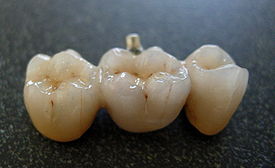- Dental porcelain
-
Dental porcelain (also known as dental ceramic) is a porcelain used by a dental technician to create biocompatible lifelike crowns, bridges, and veneers for the patient. Evidence suggests they are effective (they are biocompatible, esthetic, insoluble and have hardness of 7 on the Mohs scale), although for three-unit molars porcelain fused to metal or in complete porcelain group only zirconia-based restorations are recommended.[1]
The dentist will usually specify a shade or combination shades for different parts of the restoration, corresponding to a set of bottles in the lab containing the porcelain powder. A common shade system used is the Vita guide (Vita Classical and Vita 3D Master). There are two types of porcelain restorations: porcelain fused to metal and complete porcelain. For porcelain fused to metal, the black color of metal is first masked with an opaque layer to make it a shade of white and then consequtive layers are built up. The powder corresponding to the desired shade of dentine base is mixed with water, and then fired. Further layers are built up to mimic the natural translucency of the enamel of the tooth. The porcelain is fused to a semi-precious metal or precious metal such as gold, for extra strength. Many systems use an aluminium oxide or zirconium oxide or zirconia core instead of metal that makes complete porcelain restorations.
Recent developments in dental CAD-CAM technology have required specialized porcelains formed into sintered blocks. CAD/CAM restorations created with CEREC technology appear to last well.[2]
Dental porcelain is generally regarded as biologically inert. However, other toxicities may exist from depleted uranium and some of the other accessory materials, and the fillings may increase wear on opposing teeth.[3]
References
Footnotes
- ^ Della Bona A, Kelly JR (September 2008). "The clinical success of all-ceramic restorations". J Am Dent Assoc. 139 Suppl: 8S–13S. PMID 18768903. http://jada.ada.org/cgi/pmidlookup?view=long&pmid=18768903.
- ^ Fasbinder DJ (September 2006). "Clinical performance of chairside CAD/CAM restorations". J Am Dent Assoc. 137 Suppl: 22S–31S. PMID 16950934. http://jada.ada.org/cgi/pmidlookup?view=long&pmid=16950934.
- ^ Mackert JR (September 1992). "Side-effects of dental ceramics". Adv. Dent. Res. 6: 90–3. PMID 1337968. http://adr.iadrjournals.org/cgi/pmidlookup?view=long&pmid=1337968.

This dentistry article is a stub. You can help Wikipedia by expanding it.

